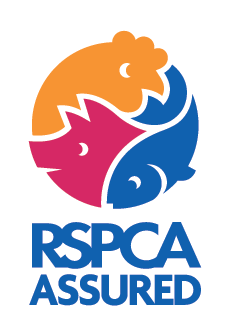Higher welfare standards for pigs
Pigs are highly intelligent and sociable animals. In the UK, around ten million pigs are farmed annually.
Key pig welfare concerns

1. Farrowing crates
Around 60% of sows (female pigs) are kept in farrowing crates for up to five weeks, around the time they give birth. While farrowing crates may help prevent the sows from lying on their piglets, they also severely restrict their movement, preventing them from being able to turn around and move freely, which can cause significant stress and frustration.
Find out more about farrowing crates and what the RSPCA says about them.
What do the RSPCA standards say?
The RSPCA standards strictly prohibit the use of farrowing crates. Instead, they require farrowing sows to be provided with a warm, comfortable environment with plenty of straw to help cushion and protect their piglets, whilst also allowing greater freedom of movement and the ability to express natural nesting behaviours.
2. Mutilations
Pigs may be subject to a number of mutilations, such as tail docking and teeth clipping of piglets and nose ringing of outdoor sows. The purpose of these procedures is to prevent potentially more harmful welfare issues. For example, piglets are tail-docked to reduce incidences of tail biting.
However, when tail biting is a problem, other means of reducing the risk, such as improving the pigs’ environment, should always be tried first, with tail docking only ever being used as a last resort.
What the RSPCA standards say
In some cases, and strictly through veterinarian request, the RSPCA allows pigs to be tail docked, have their teeth clipped or fitted with a nose ring. This is only permitted when a vet has provided evidence that the procedure is needed to overcome a serious welfare issue, and when other approaches, such as improving the pigs’ environment, have already been tried and failed. In these cases, there are standards to permit these procedures, but only when carried out by a trained individual with the correct equipment.
The RSPCA continues to seek ways of avoiding the need for mutilations, with the ultimate aim of moving away from allowing them at all in the future.
3. Barren environments
Many pigs are kept in crowded conditions, on bare slatted or concrete floors. As well as being uncomfortable, these conditions can increase the risk of foot and leg problems, including lameness. Slatted floors also limit how much straw or other materials can be given since they fall through the gaps. This reduces the pigs’ opportunity to carry out natural and stimulating ‘rooting’ behaviours. This can lead to boredom and frustration, which in turn may lead to other problem behaviours like biting other pigs’ tails.
What the RSPCA standards say…
The RSPCA standards do not allow pigs to be kept on bare slatted or concrete floors. RSPCA Assured pigs must be provided with plenty of space, comfortable bedding and materials to root around in. This helps to reduce unwanted behaviours like tail biting. The pigs must also be provided with a dry, warm and comfortable shelter when living outside, as well as facilities to minimise the risk of sunburn, this could be something like mud wallows.
Free-range alone is not a guarantee of good welfare any more than indoor is a guarantee of bad welfare.





